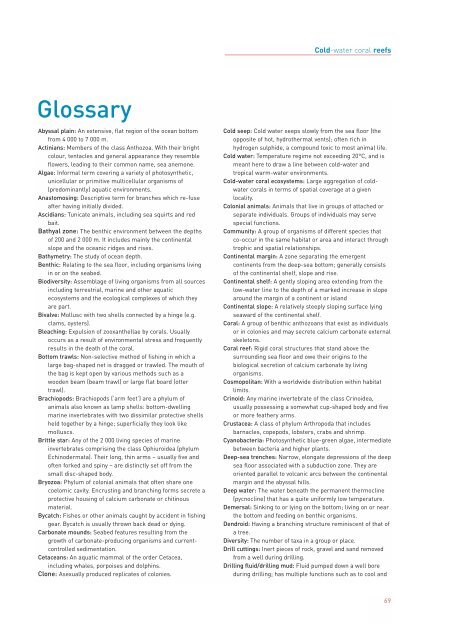Cold-water coral reefs - WWF UK
Cold-water coral reefs - WWF UK
Cold-water coral reefs - WWF UK
You also want an ePaper? Increase the reach of your titles
YUMPU automatically turns print PDFs into web optimized ePapers that Google loves.
<strong>Cold</strong>-<strong>water</strong> <strong>coral</strong> <strong>reefs</strong><br />
Glossary<br />
Abyssal plain: An extensive, flat region of the ocean bottom<br />
from 4 000 to 7 000 m.<br />
Actinians: Members of the class Anthozoa. With their bright<br />
colour, tentacles and general appearance they resemble<br />
flowers, leading to their common name, sea anemone.<br />
Algae: Informal term covering a variety of photosynthetic,<br />
unicellular or primitive multicellular organisms of<br />
(predominantly) aquatic environments.<br />
Anastomosing: Descriptive term for branches which re-fuse<br />
after having initially divided.<br />
Ascidians: Tunicate animals, including sea squirts and red<br />
bait.<br />
Bathyal zone: The benthic environment between the depths<br />
of 200 and 2 000 m. It includes mainly the continental<br />
slope and the oceanic ridges and rises.<br />
Bathymetry: The study of ocean depth.<br />
Benthic: Relating to the sea floor, including organisms living<br />
in or on the seabed.<br />
Biodiversity: Assemblage of living organisms from all sources<br />
including terrestrial, marine and other aquatic<br />
ecosystems and the ecological complexes of which they<br />
are part.<br />
Bivalve: Mollusc with two shells connected by a hinge (e.g.<br />
clams, oysters).<br />
Bleaching: Expulsion of zooxanthellae by <strong>coral</strong>s. Usually<br />
occurs as a result of environmental stress and frequently<br />
results in the death of the <strong>coral</strong>.<br />
Bottom trawls: Non-selective method of fishing in which a<br />
large bag-shaped net is dragged or trawled. The mouth of<br />
the bag is kept open by various methods such as a<br />
wooden beam (beam trawl) or large flat board (otter<br />
trawl).<br />
Brachiopods: Brachiopods (‘arm feet’) are a phylum of<br />
animals also known as lamp shells: bottom-dwelling<br />
marine invertebrates with two dissimilar protective shells<br />
held together by a hinge; superficially they look like<br />
molluscs.<br />
Brittle star: Any of the 2 000 living species of marine<br />
invertebrates comprising the class Ophiuroidea (phylum<br />
Echinodermata). Their long, thin arms – usually five and<br />
often forked and spiny – are distinctly set off from the<br />
small disc-shaped body.<br />
Bryozoa: Phylum of colonial animals that often share one<br />
coelomic cavity. Encrusting and branching forms secrete a<br />
protective housing of calcium carbonate or chitinous<br />
material.<br />
Bycatch: Fishes or other animals caught by accident in fishing<br />
gear. Bycatch is usually thrown back dead or dying.<br />
Carbonate mounds: Seabed features resulting from the<br />
growth of carbonate-producing organisms and currentcontrolled<br />
sedimentation.<br />
Cetaceans: An aquatic mammal of the order Cetacea,<br />
including whales, porpoises and dolphins.<br />
Clone: Asexually produced replicates of colonies.<br />
<strong>Cold</strong> seep: <strong>Cold</strong> <strong>water</strong> seeps slowly from the sea floor (the<br />
opposite of hot, hydrothermal vents); often rich in<br />
hydrogen sulphide, a compound toxic to most animal life.<br />
<strong>Cold</strong> <strong>water</strong>: Temperature regime not exceeding 20°C, and is<br />
meant here to draw a line between cold-<strong>water</strong> and<br />
tropical warm-<strong>water</strong> environments.<br />
<strong>Cold</strong>-<strong>water</strong> <strong>coral</strong> ecosystems: Large aggregation of cold<strong>water</strong><br />
<strong>coral</strong>s in terms of spatial coverage at a given<br />
locality.<br />
Colonial animals: Animals that live in groups of attached or<br />
separate individuals. Groups of individuals may serve<br />
special functions.<br />
Community: A group of organisms of different species that<br />
co-occur in the same habitat or area and interact through<br />
trophic and spatial relationships.<br />
Continental margin: A zone separating the emergent<br />
continents from the deep-sea bottom; generally consists<br />
of the continental shelf, slope and rise.<br />
Continental shelf: A gently sloping area extending from the<br />
low-<strong>water</strong> line to the depth of a marked increase in slope<br />
around the margin of a continent or island<br />
Continental slope: A relatively steeply sloping surface lying<br />
seaward of the continental shelf.<br />
Coral: A group of benthic anthozoans that exist as individuals<br />
or in colonies and may secrete calcium carbonate external<br />
skeletons.<br />
Coral reef: Rigid <strong>coral</strong> structures that stand above the<br />
surrounding sea floor and owe their origins to the<br />
biological secretion of calcium carbonate by living<br />
organisms.<br />
Cosmopolitan: With a worldwide distribution within habitat<br />
limits.<br />
Crinoid: Any marine invertebrate of the class Crinoidea,<br />
usually possessing a somewhat cup-shaped body and five<br />
or more feathery arms.<br />
Crustacea: A class of phylum Arthropoda that includes<br />
barnacles, copepods, lobsters, crabs and shrimp.<br />
Cyanobacteria: Photosynthetic blue-green algae, intermediate<br />
between bacteria and higher plants.<br />
Deep-sea trenches: Narrow, elongate depressions of the deep<br />
sea floor associated with a subduction zone. They are<br />
oriented parallel to volcanic arcs between the continental<br />
margin and the abyssal hills.<br />
Deep <strong>water</strong>: The <strong>water</strong> beneath the permanent thermocline<br />
(pycnocline) that has a quite uniformly low temperature.<br />
Demersal: Sinking to or lying on the bottom; living on or near<br />
the bottom and feeding on benthic organisms.<br />
Dendroid: Having a branching structure reminiscent of that of<br />
a tree.<br />
Diversity: The number of taxa in a group or place.<br />
Drill cuttings: Inert pieces of rock, gravel and sand removed<br />
from a well during drilling.<br />
Drilling fluid/drilling mud: Fluid pumped down a well bore<br />
during drilling; has multiple functions such as to cool and<br />
69
















